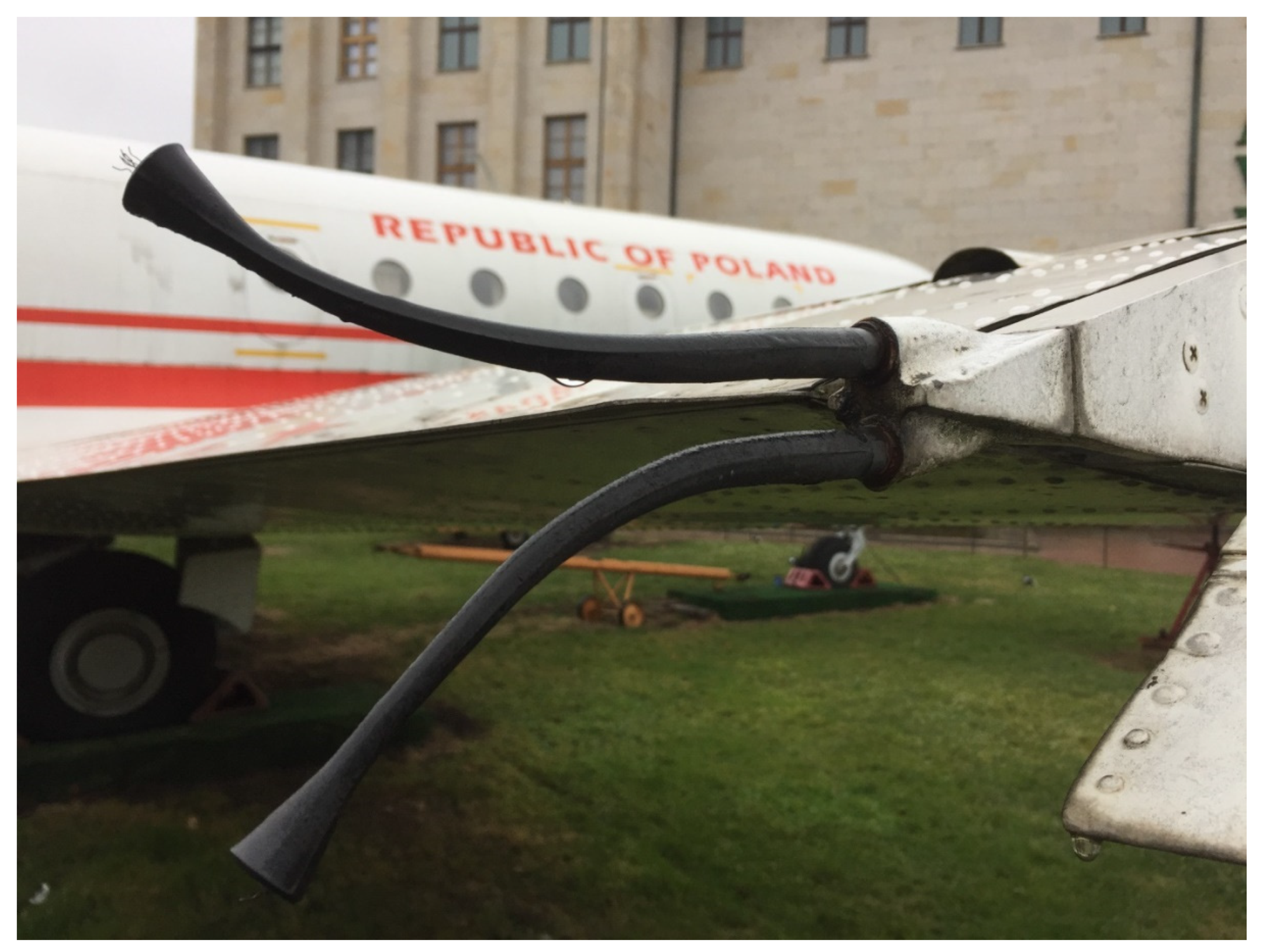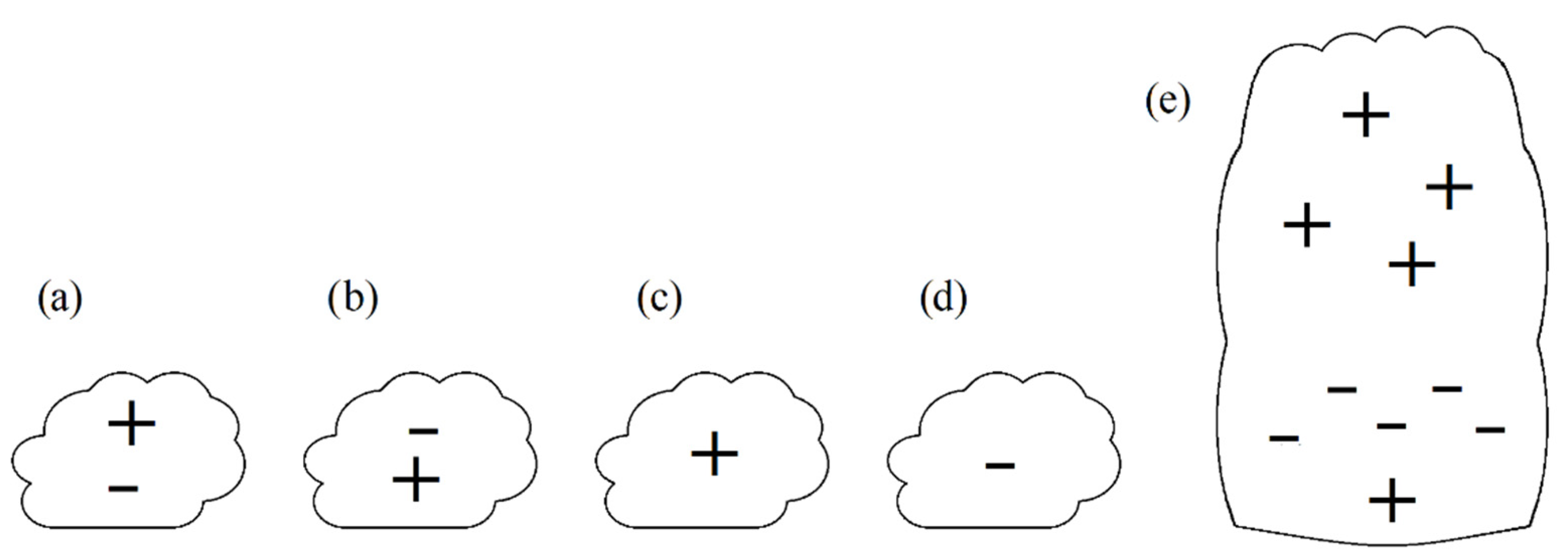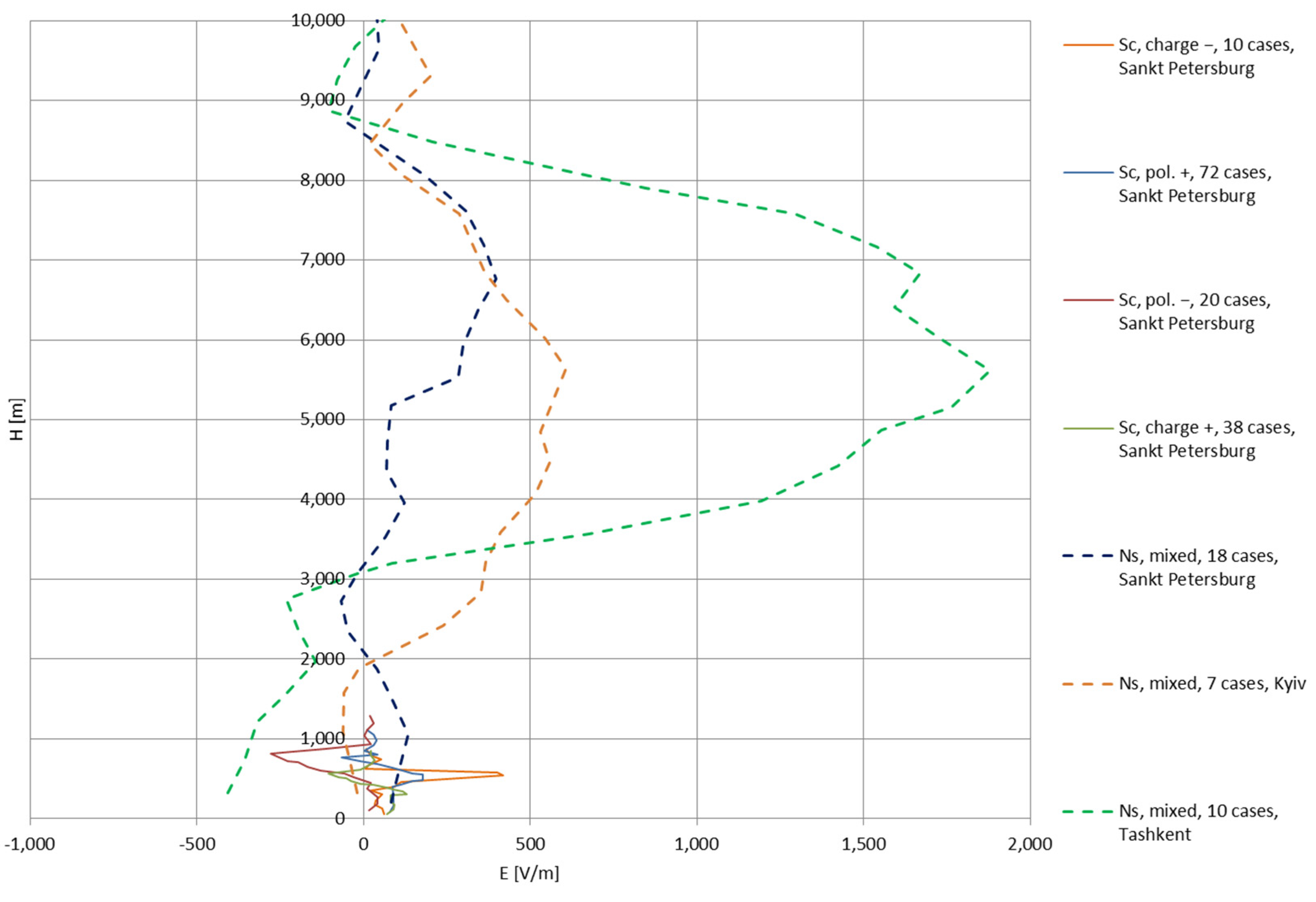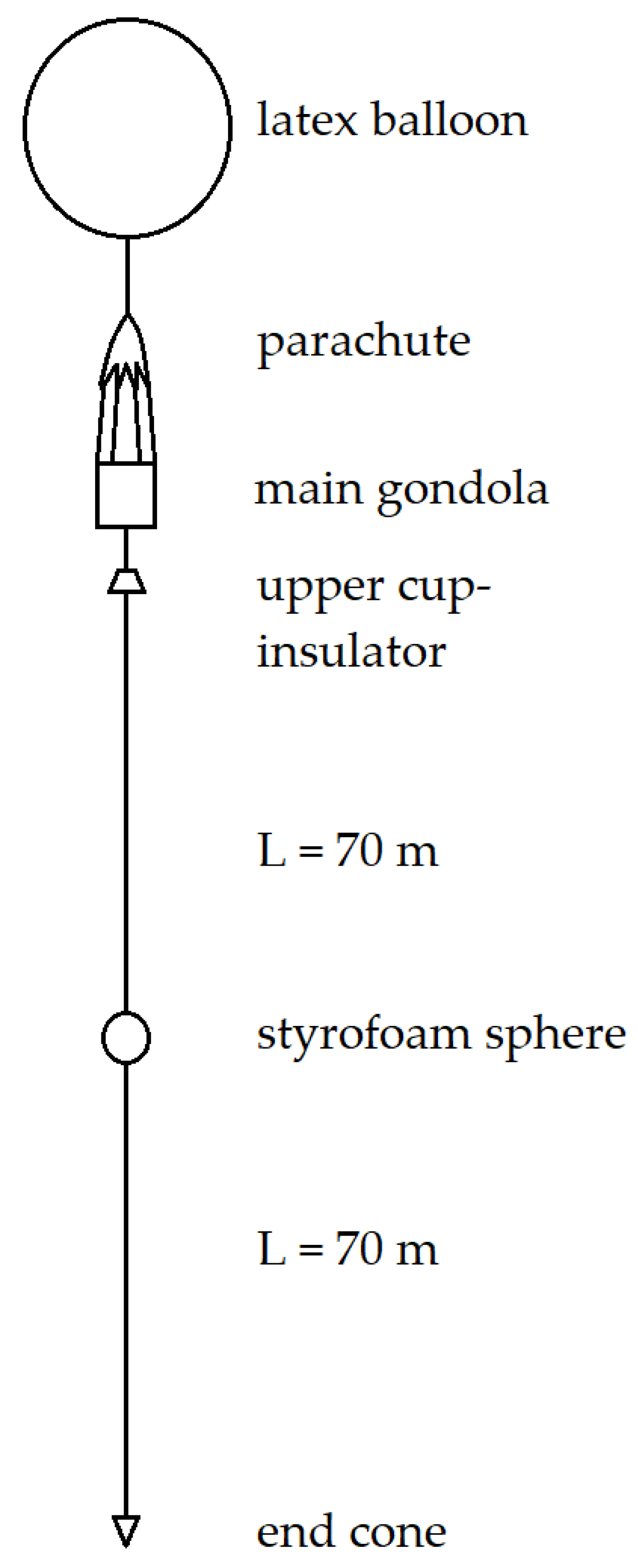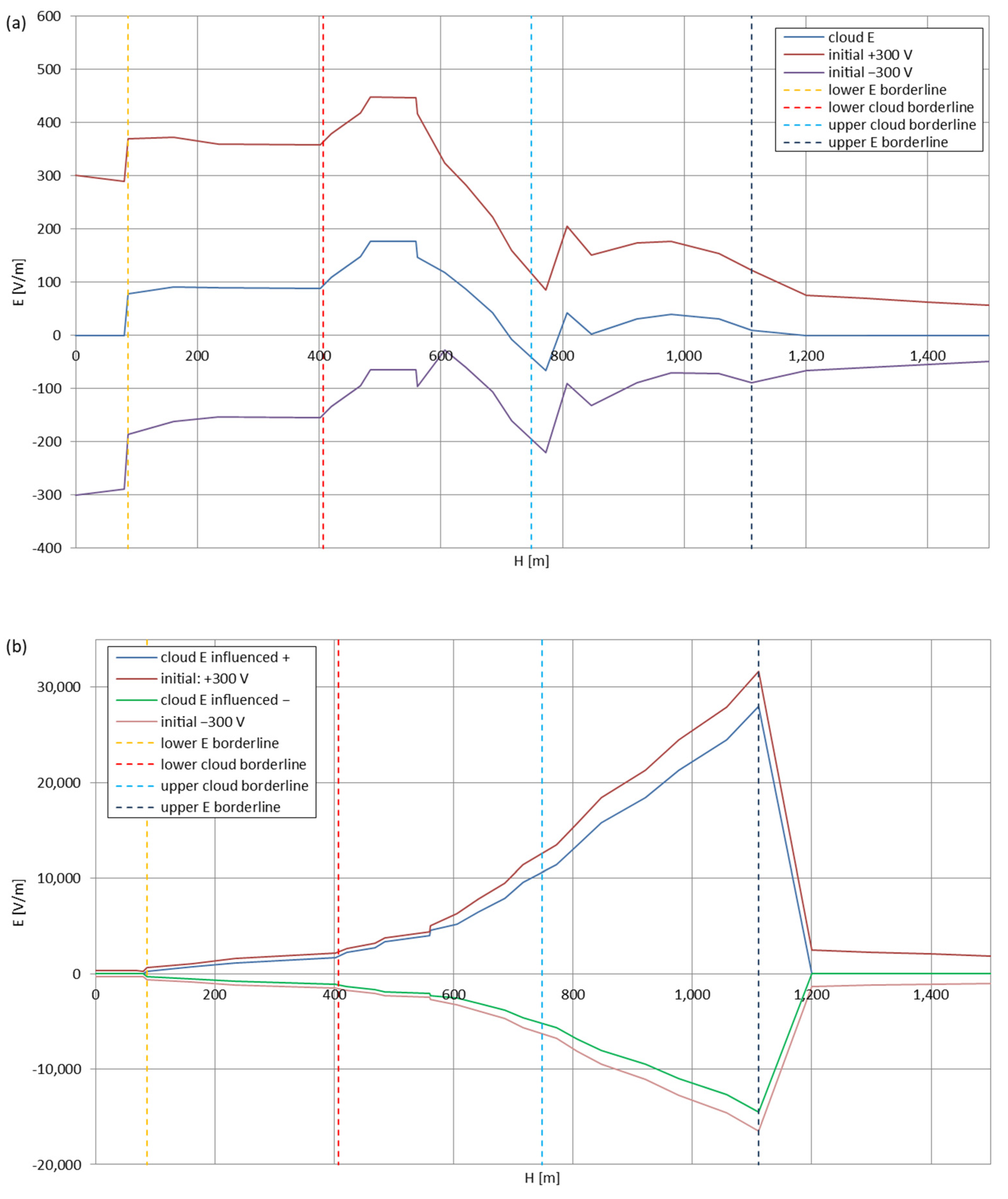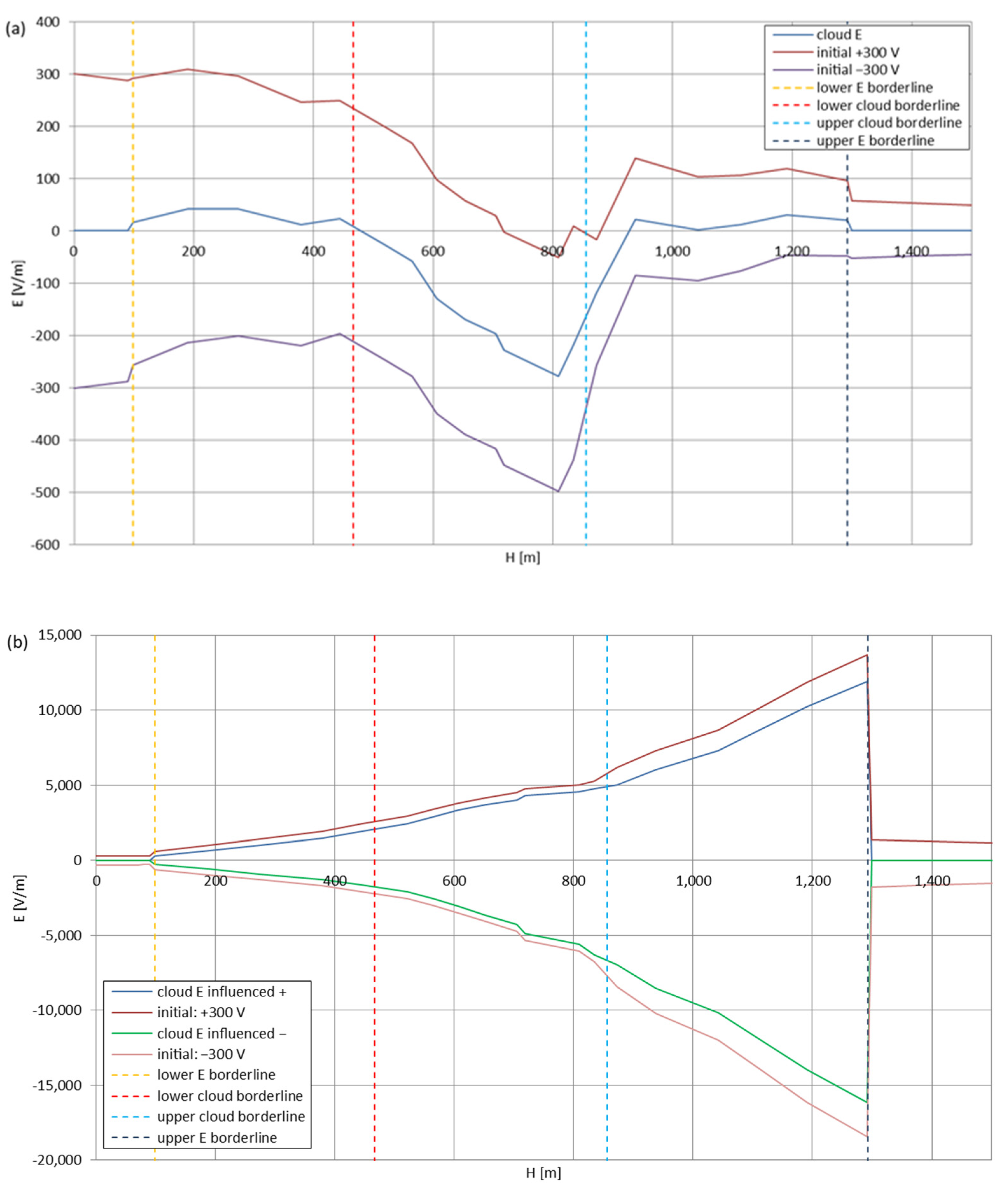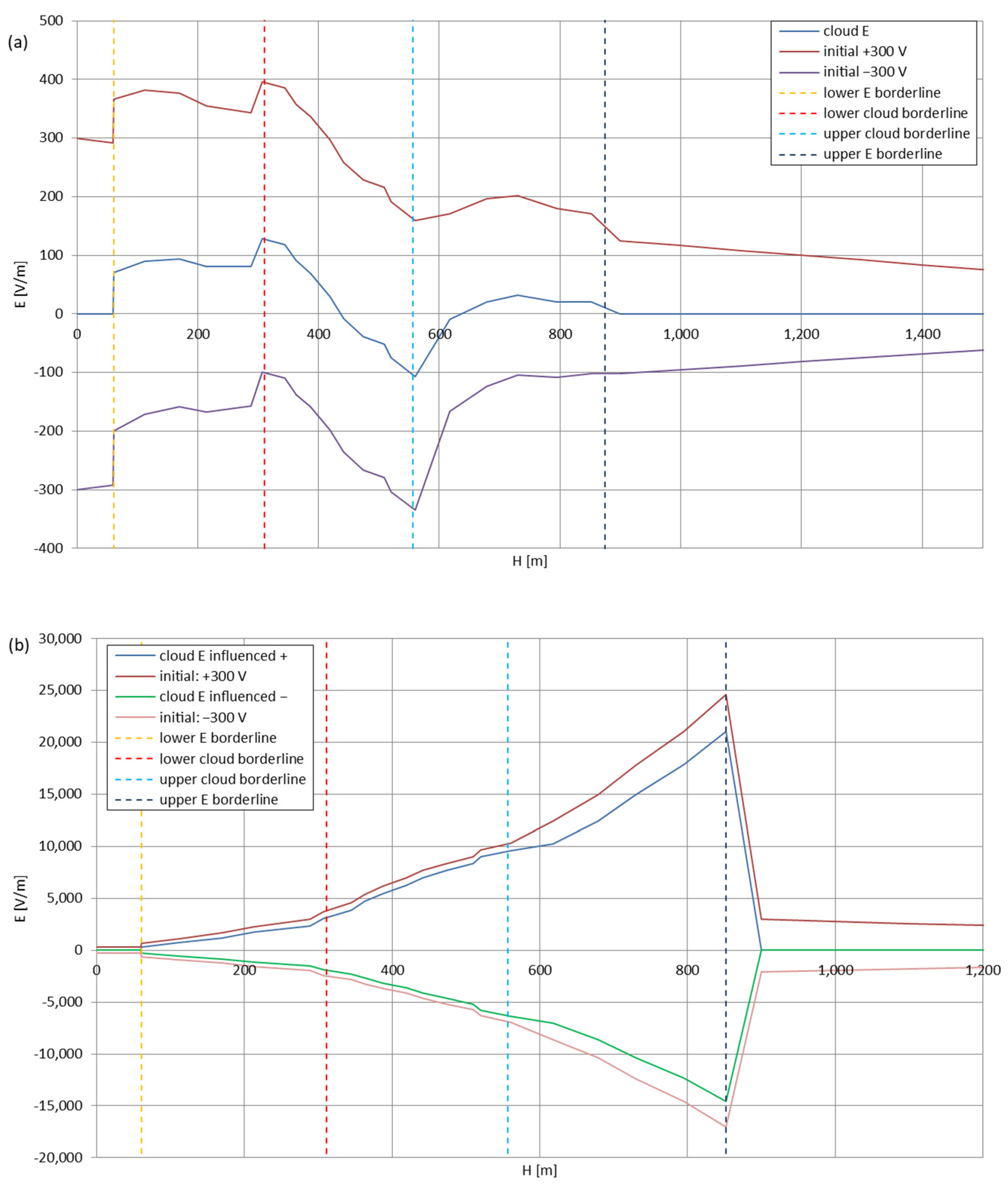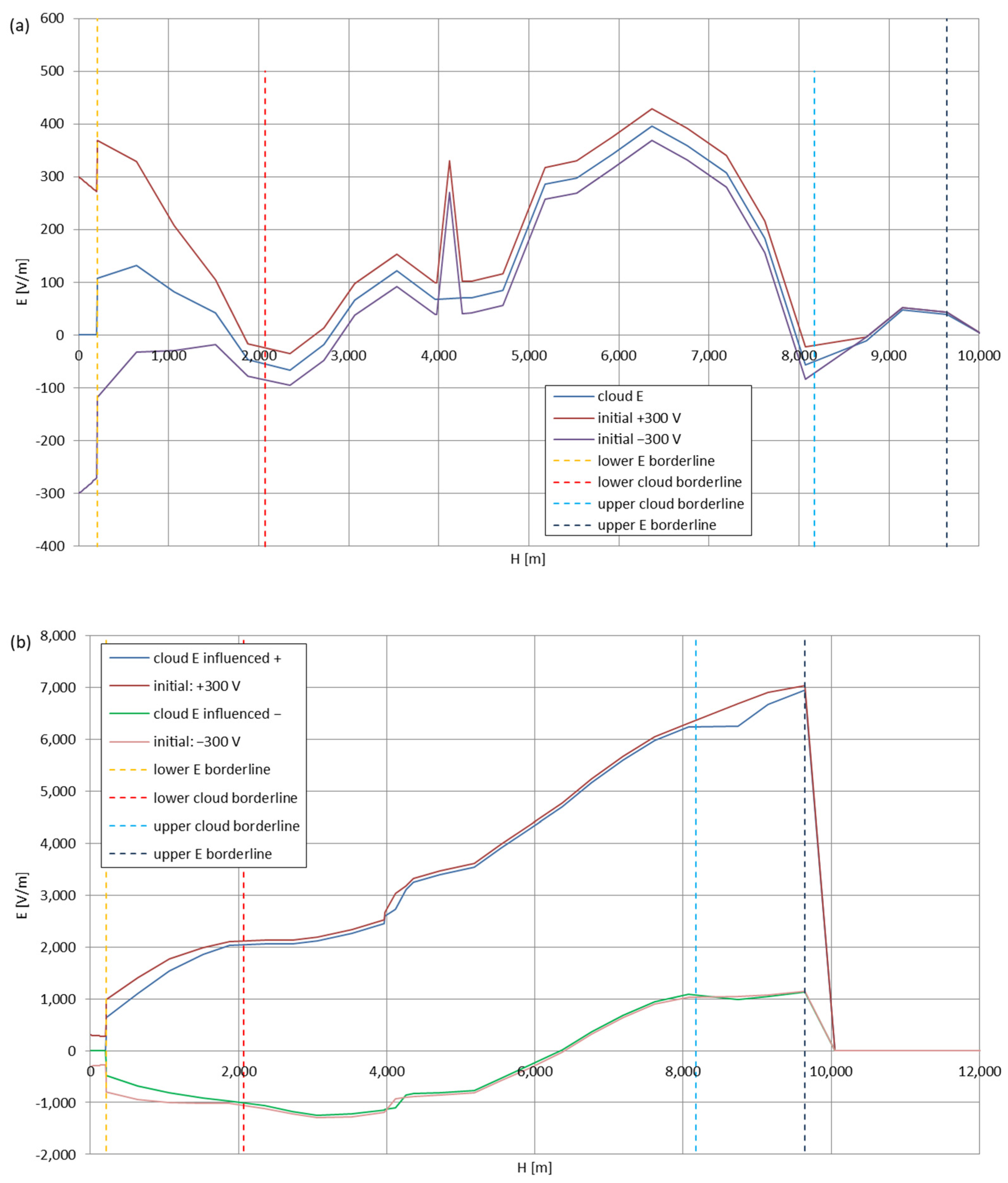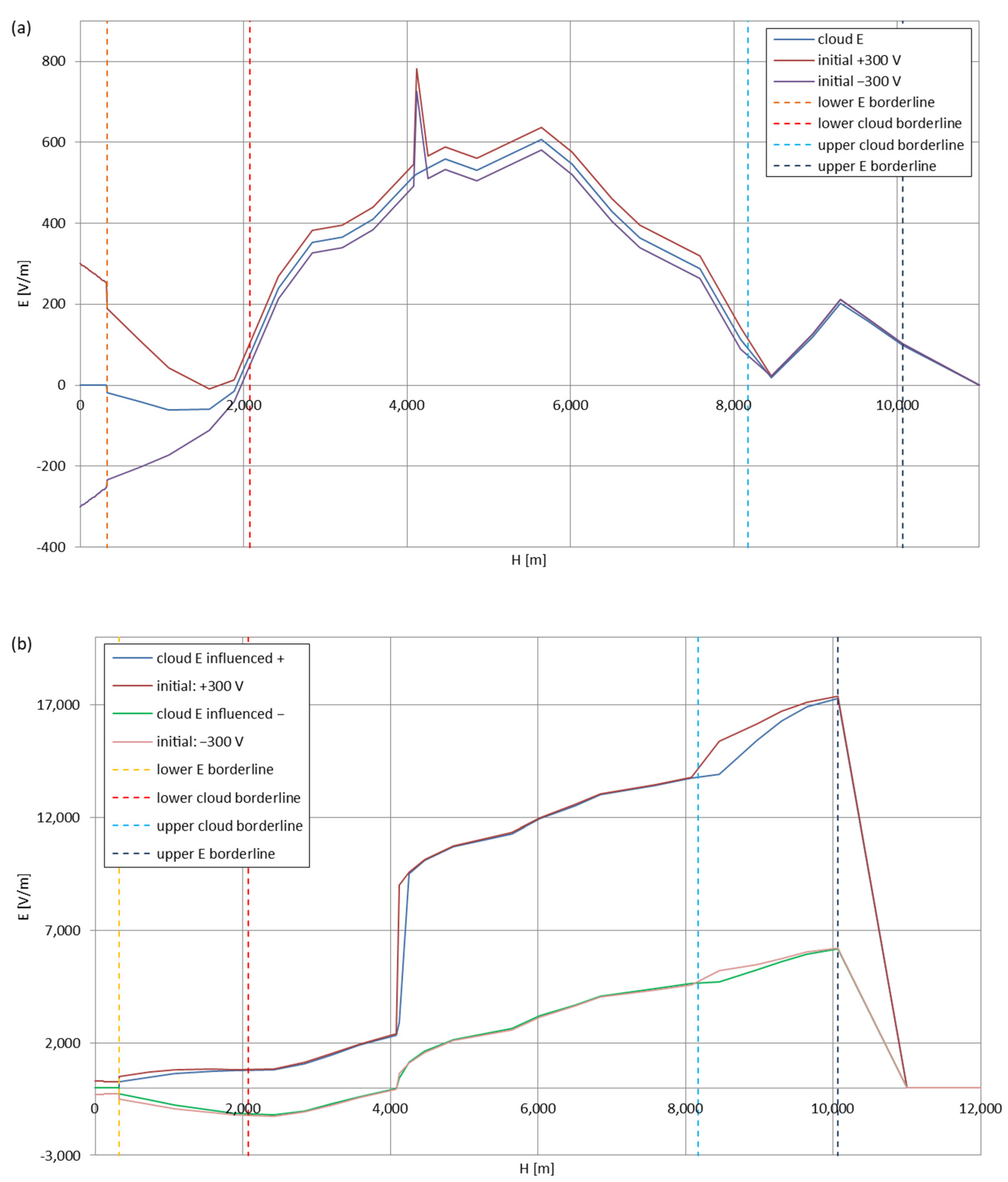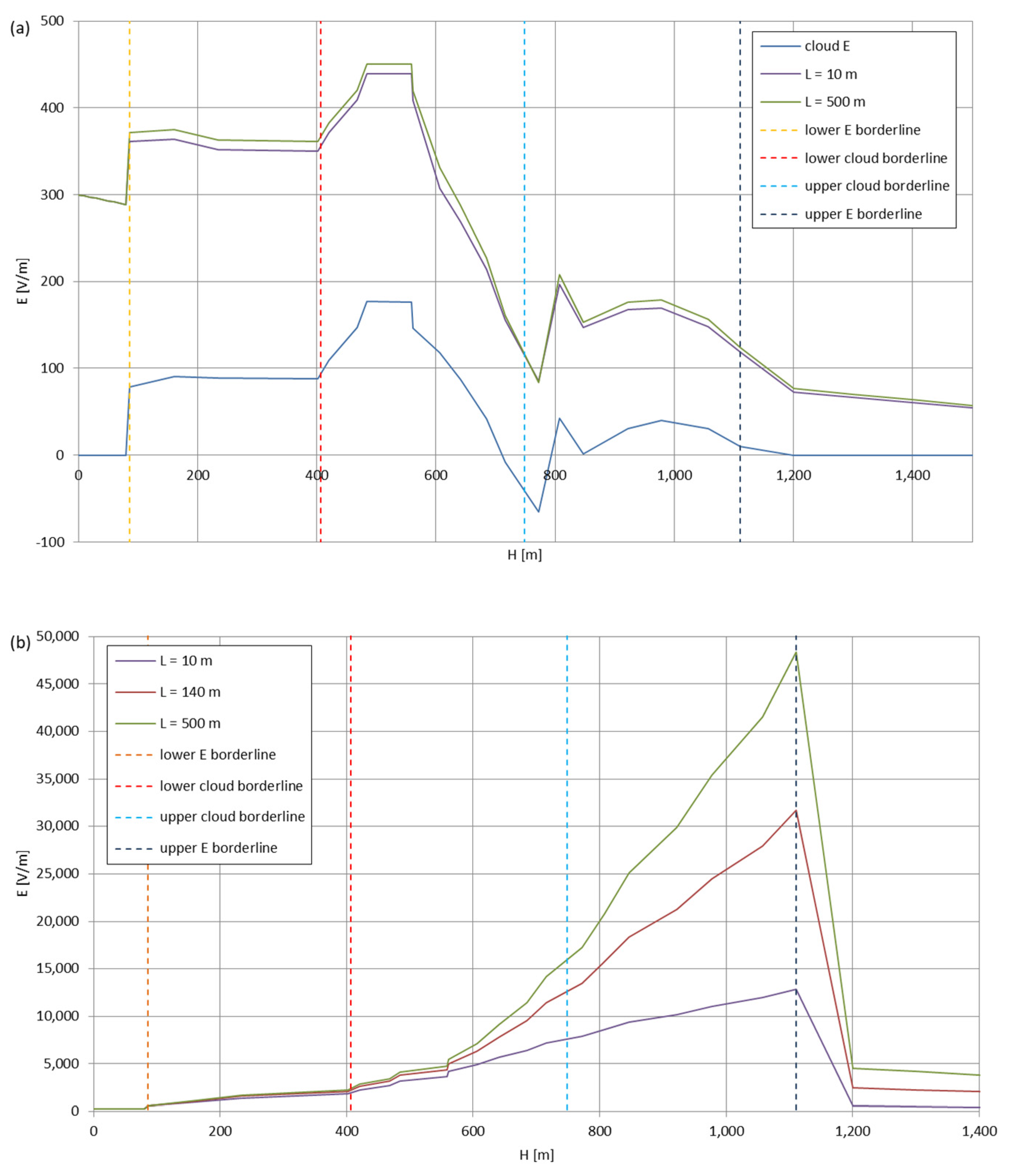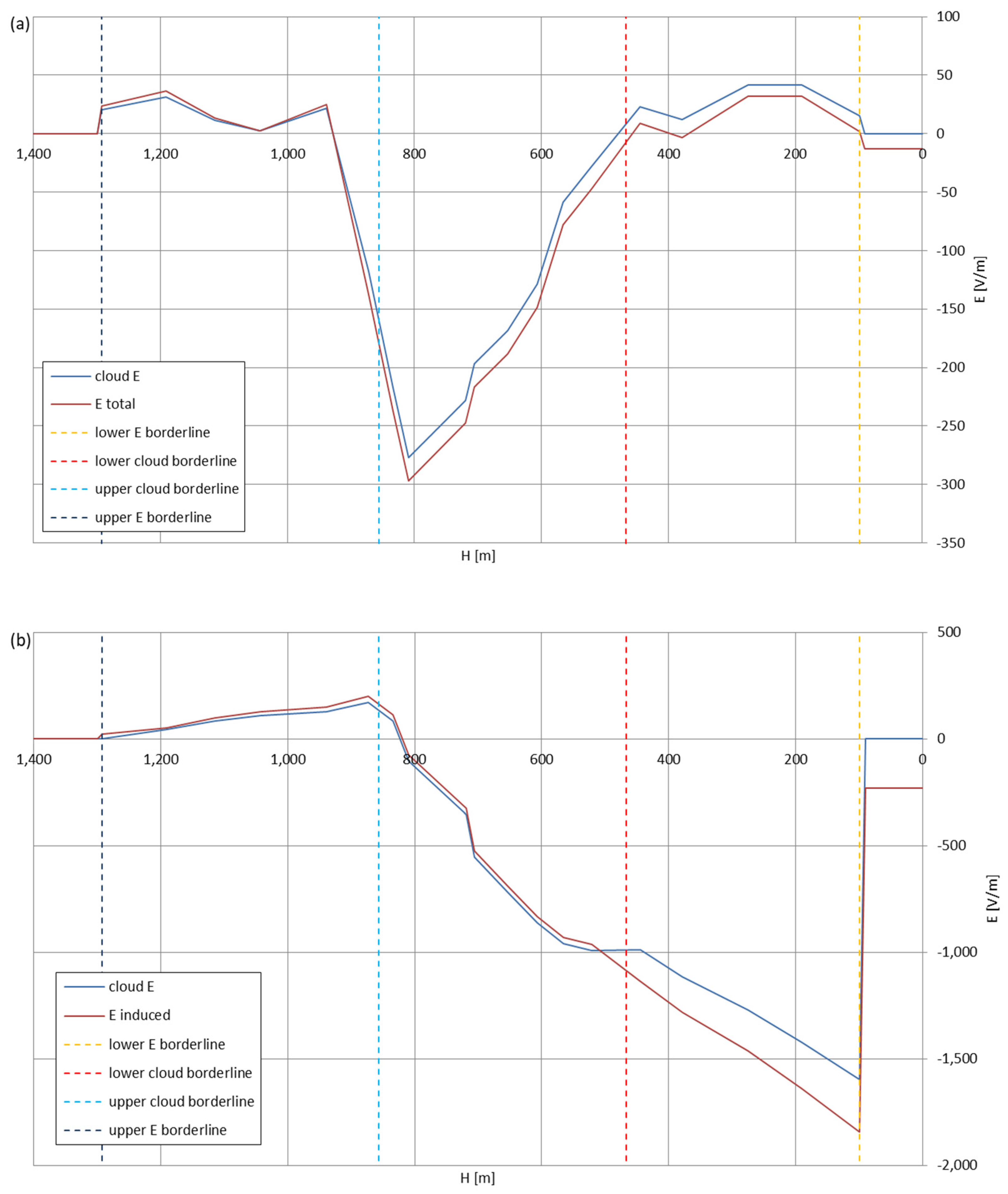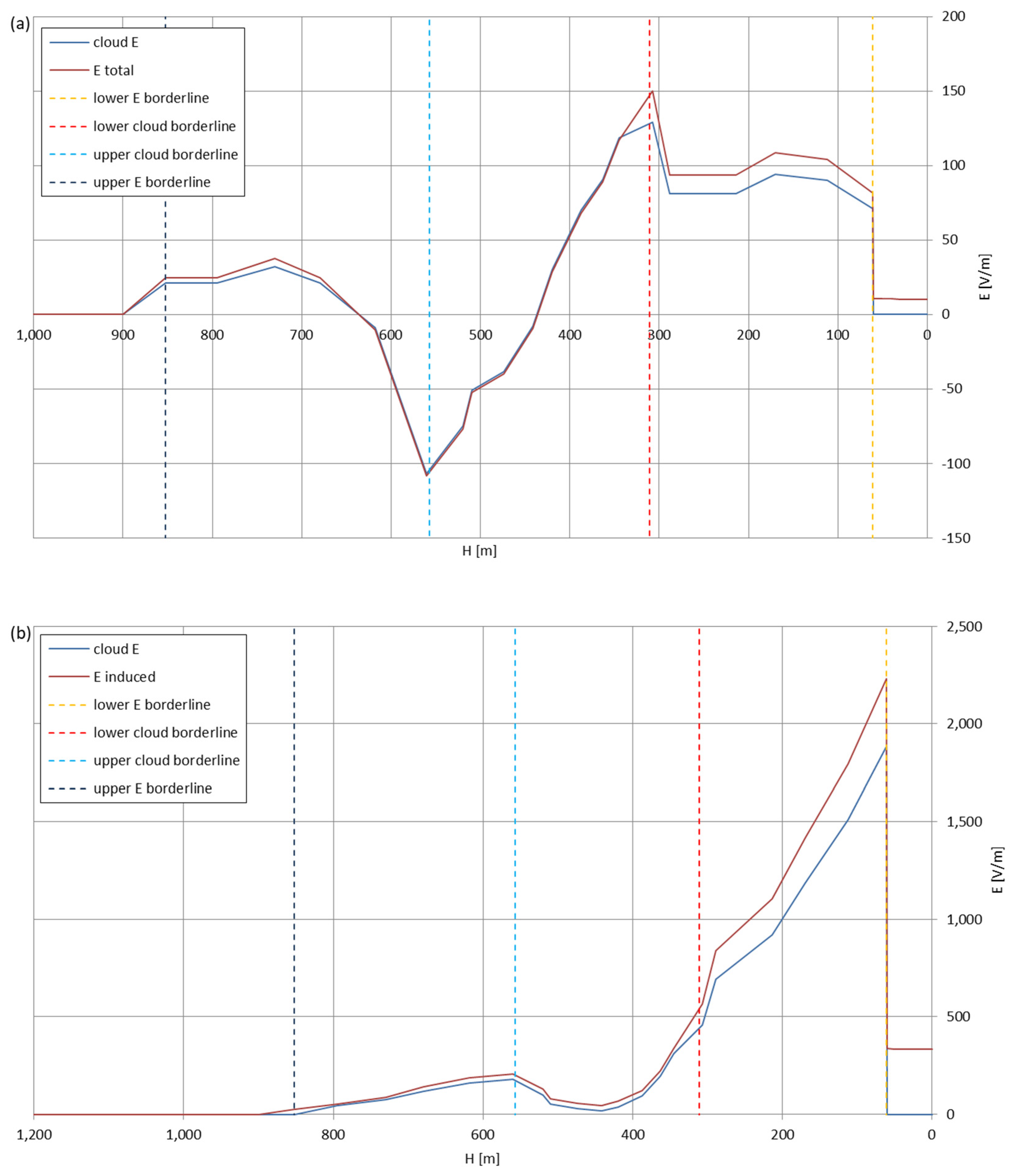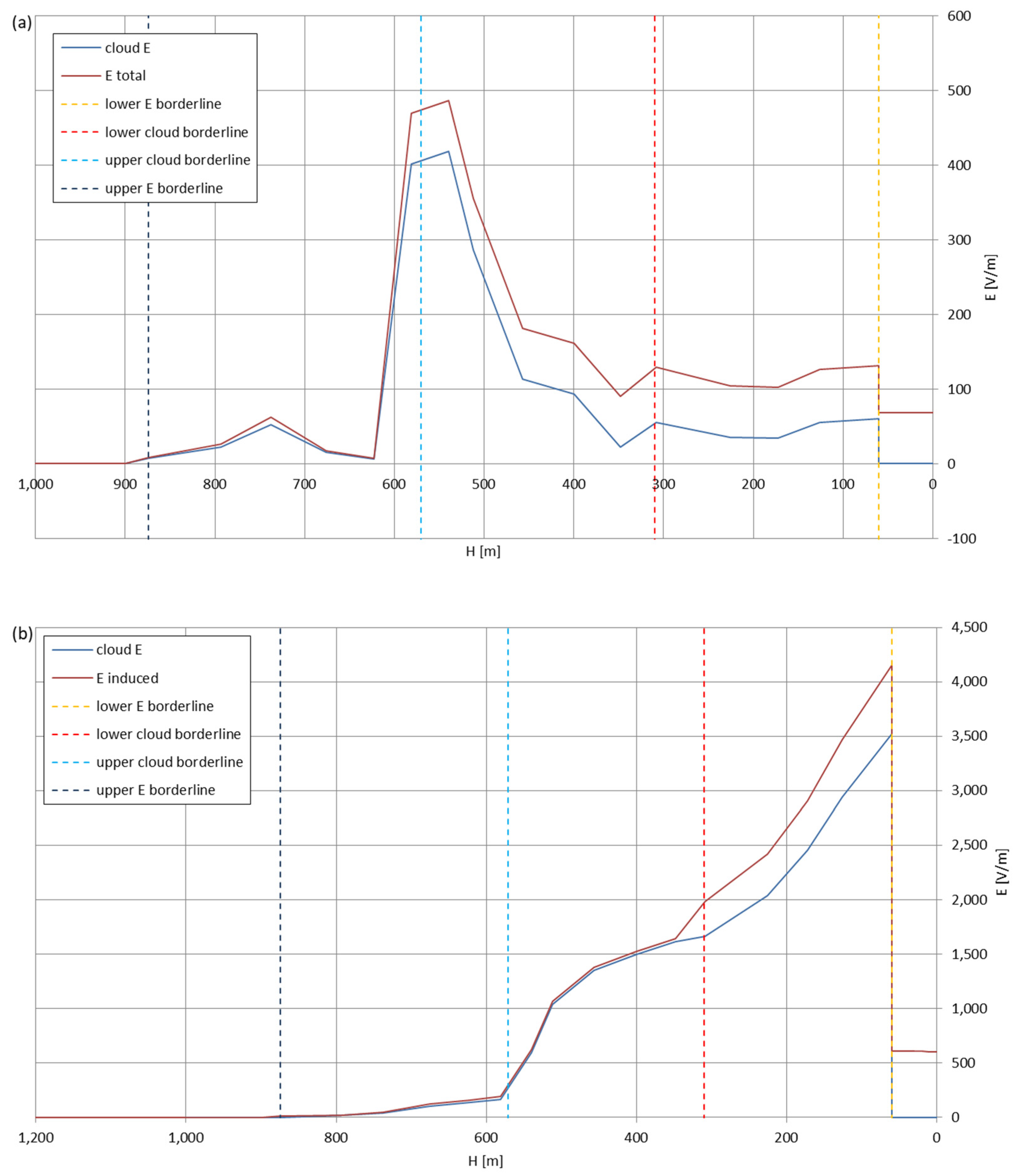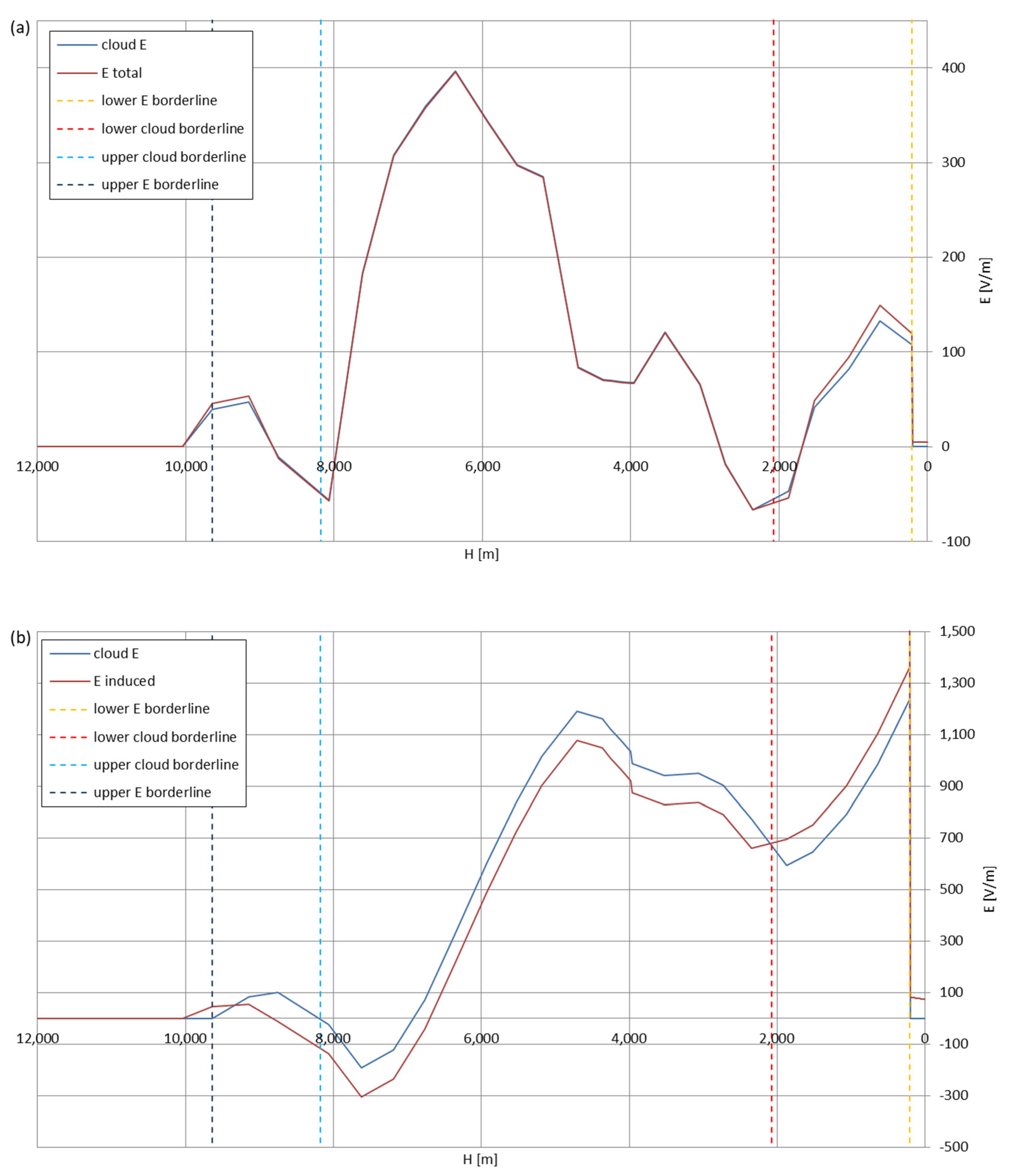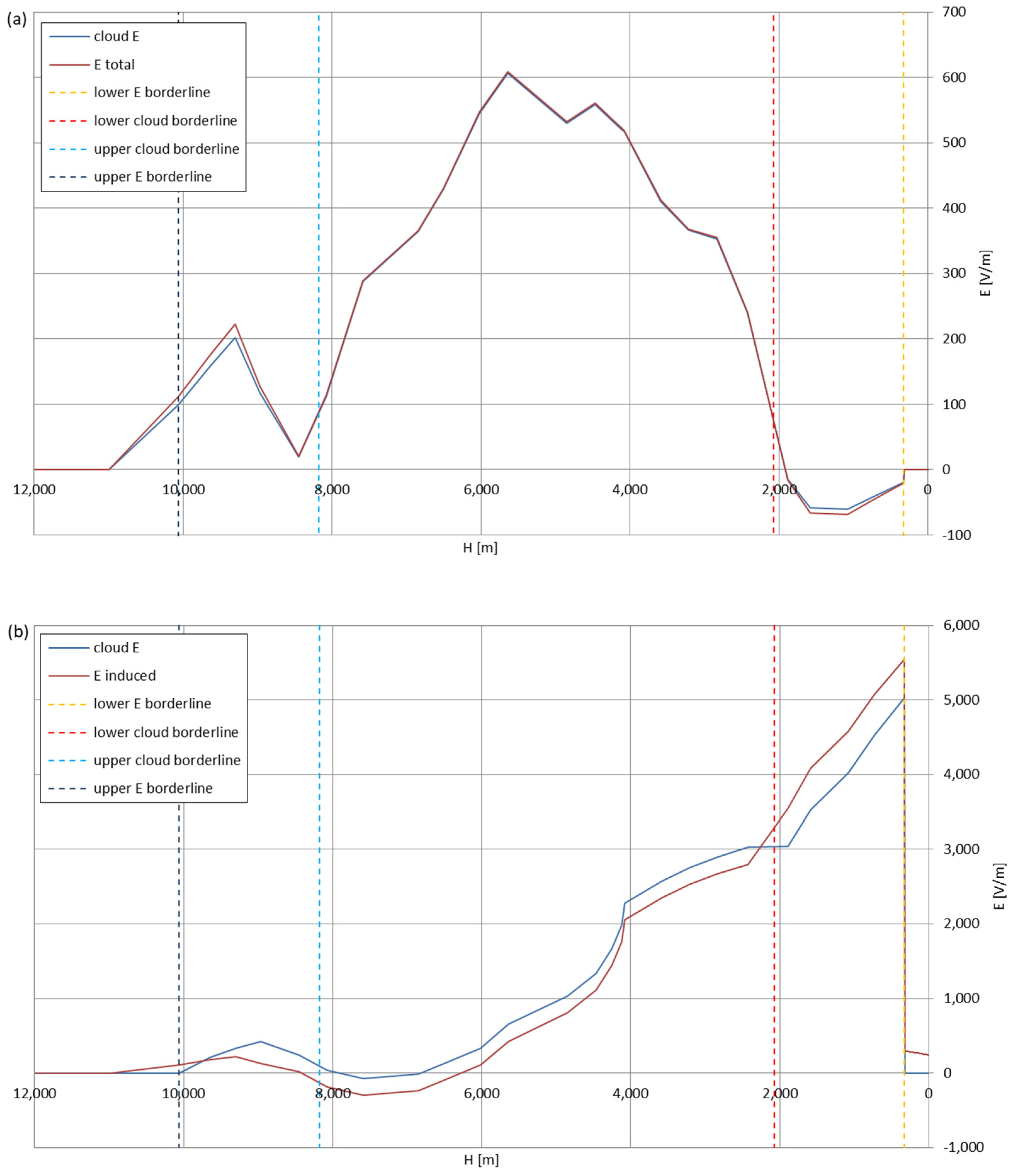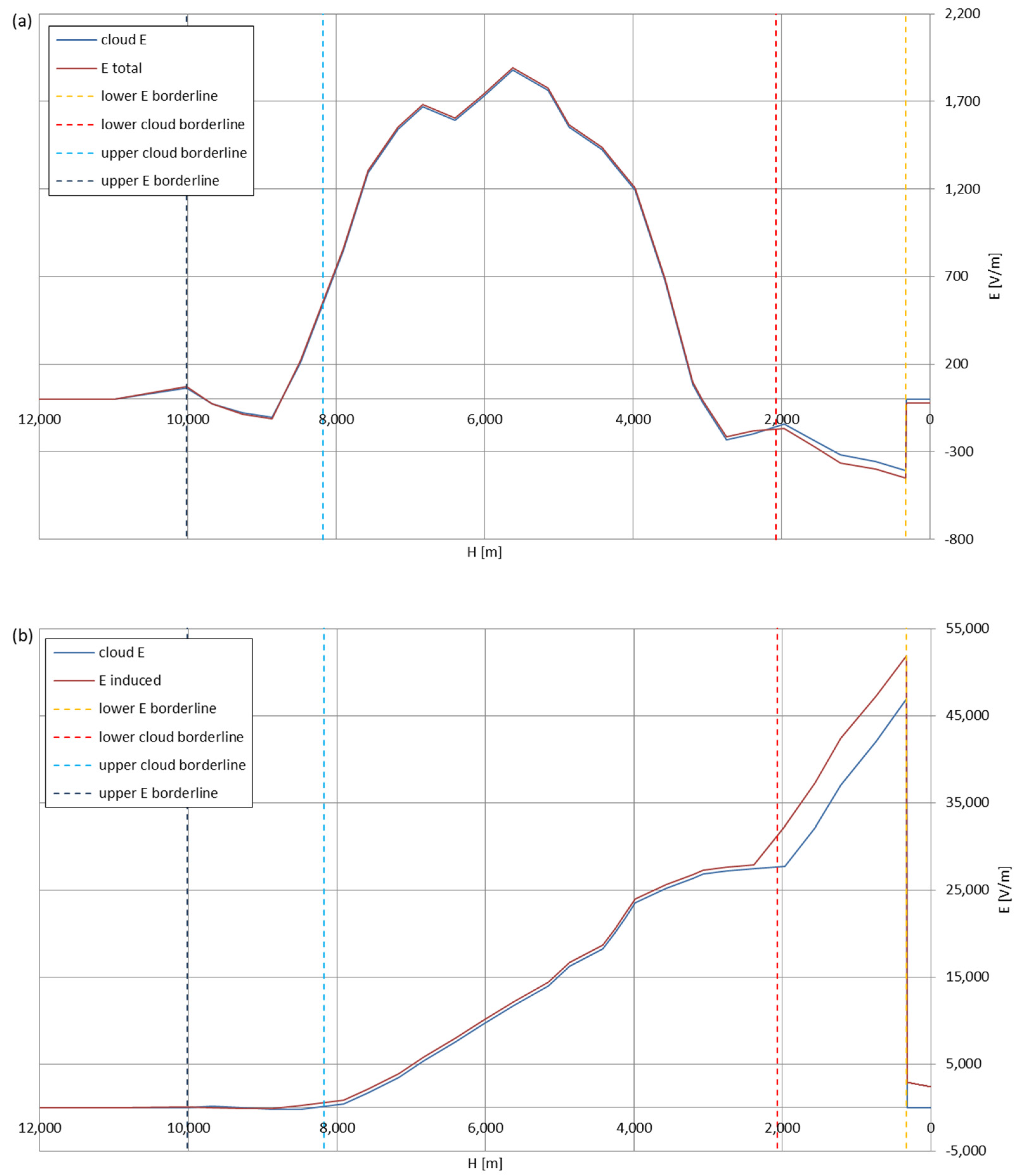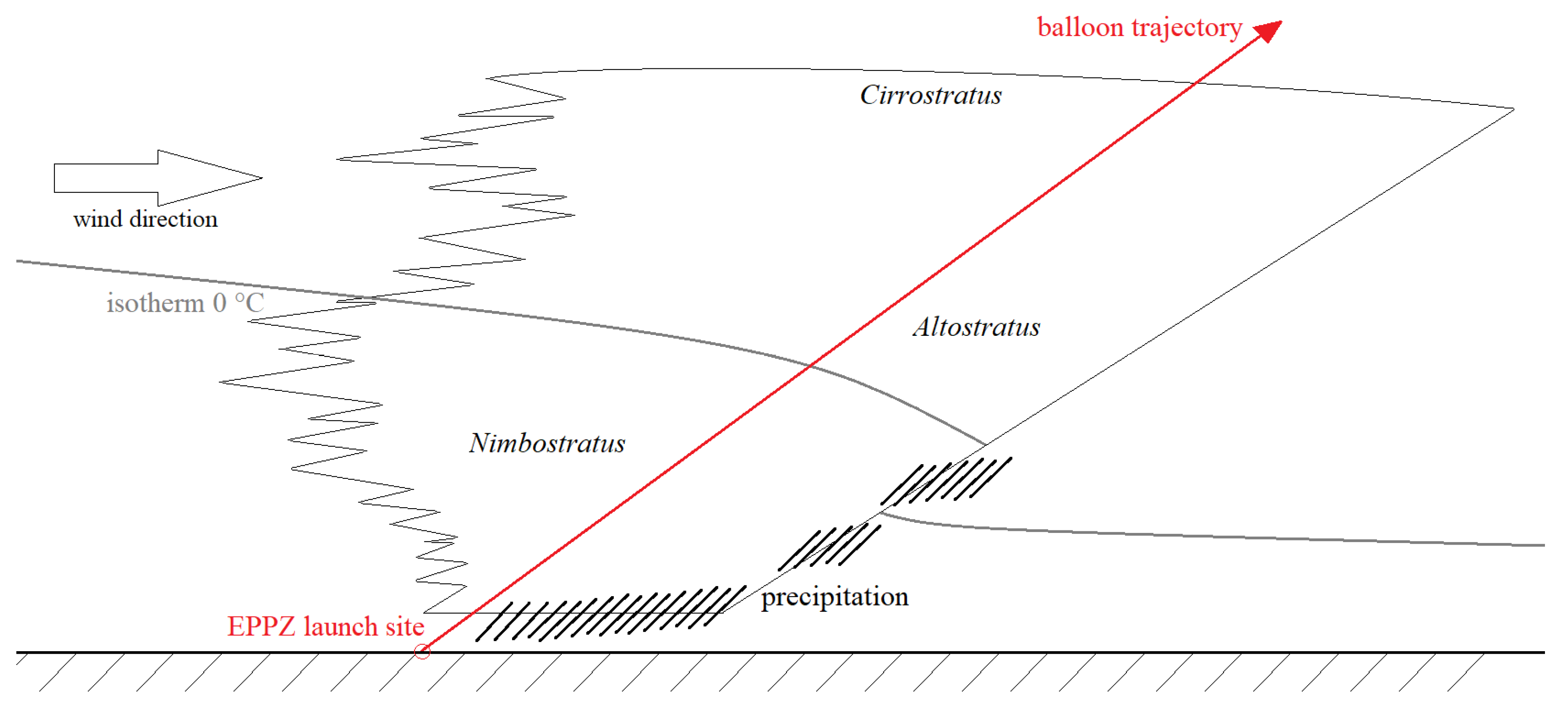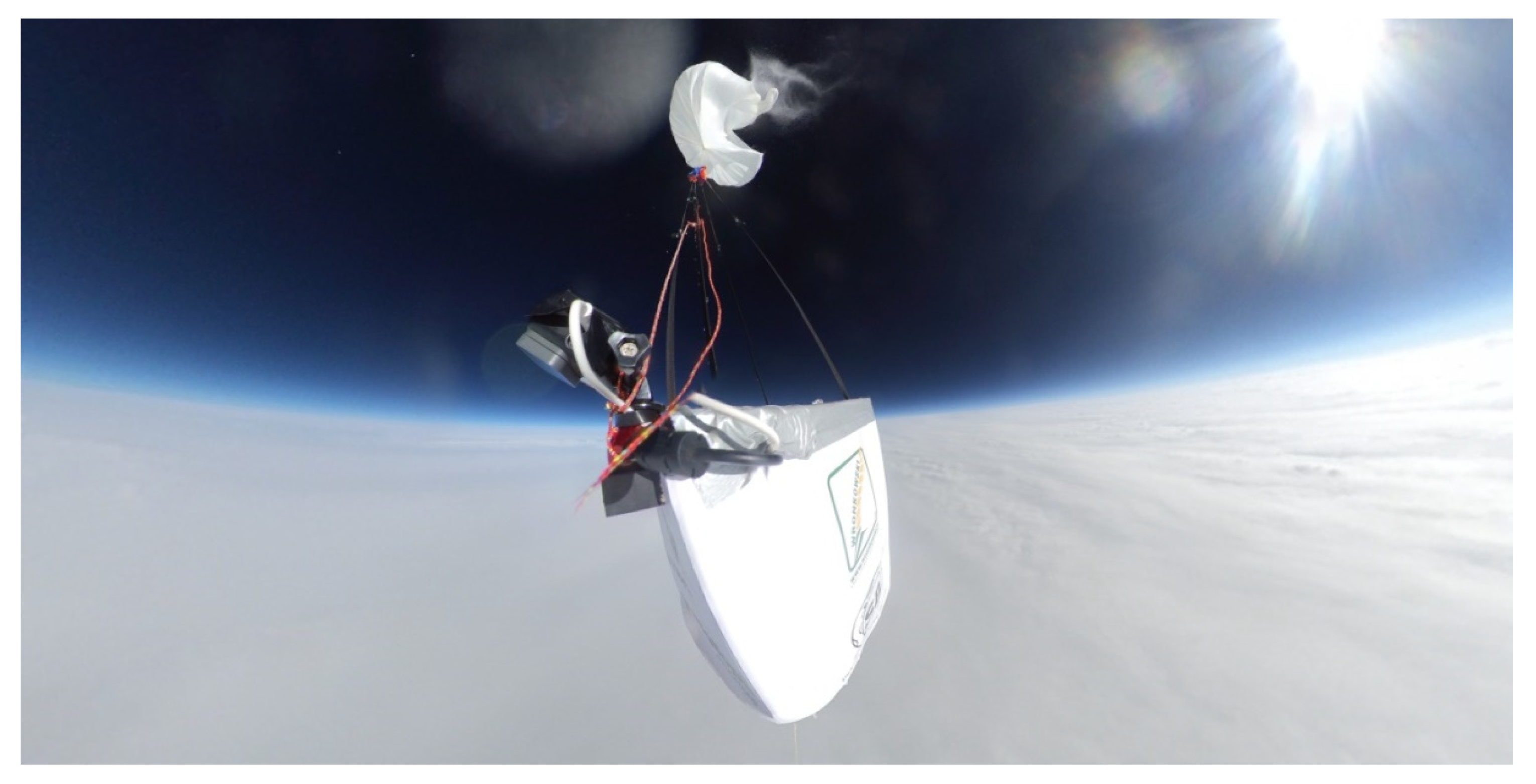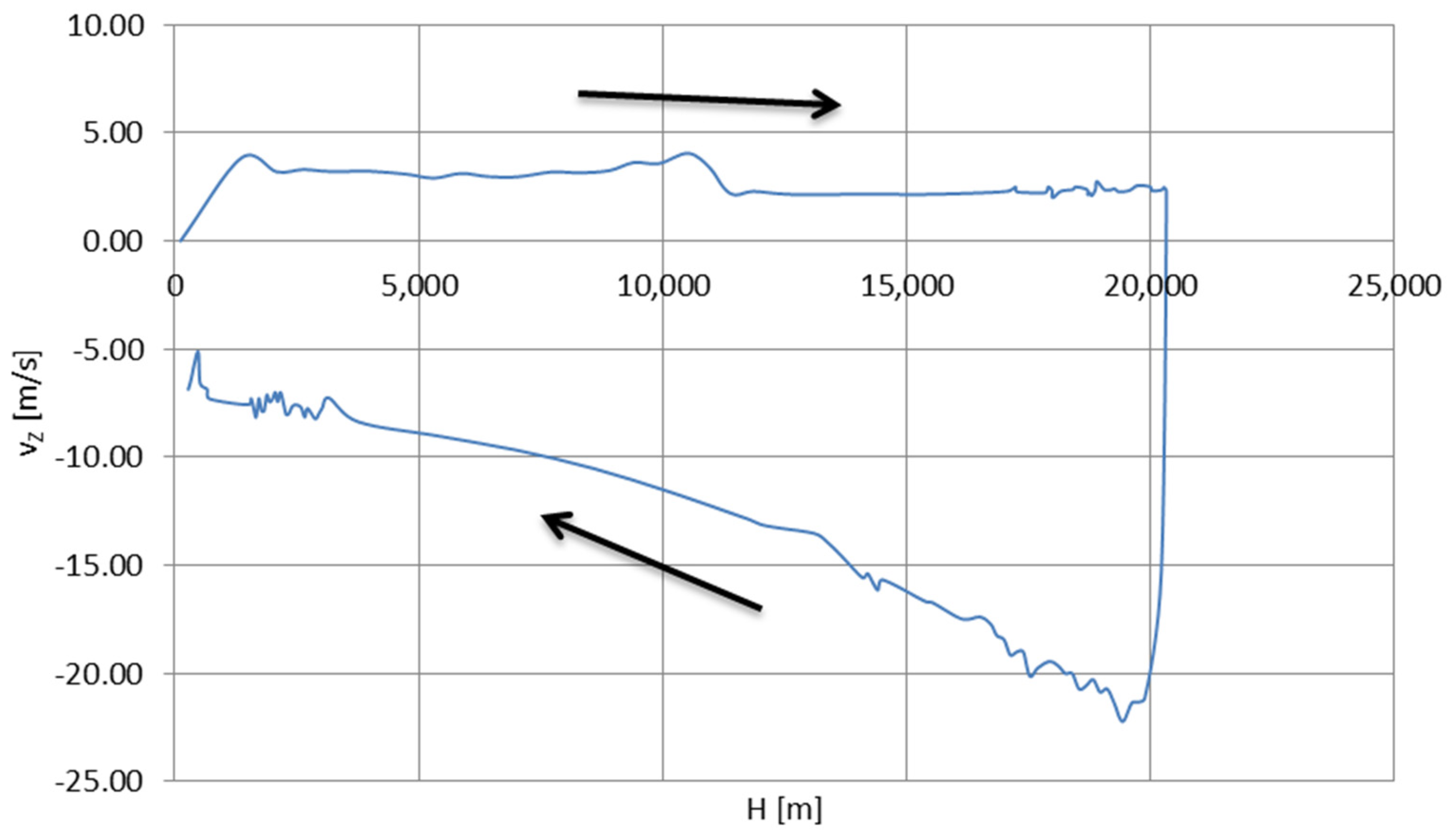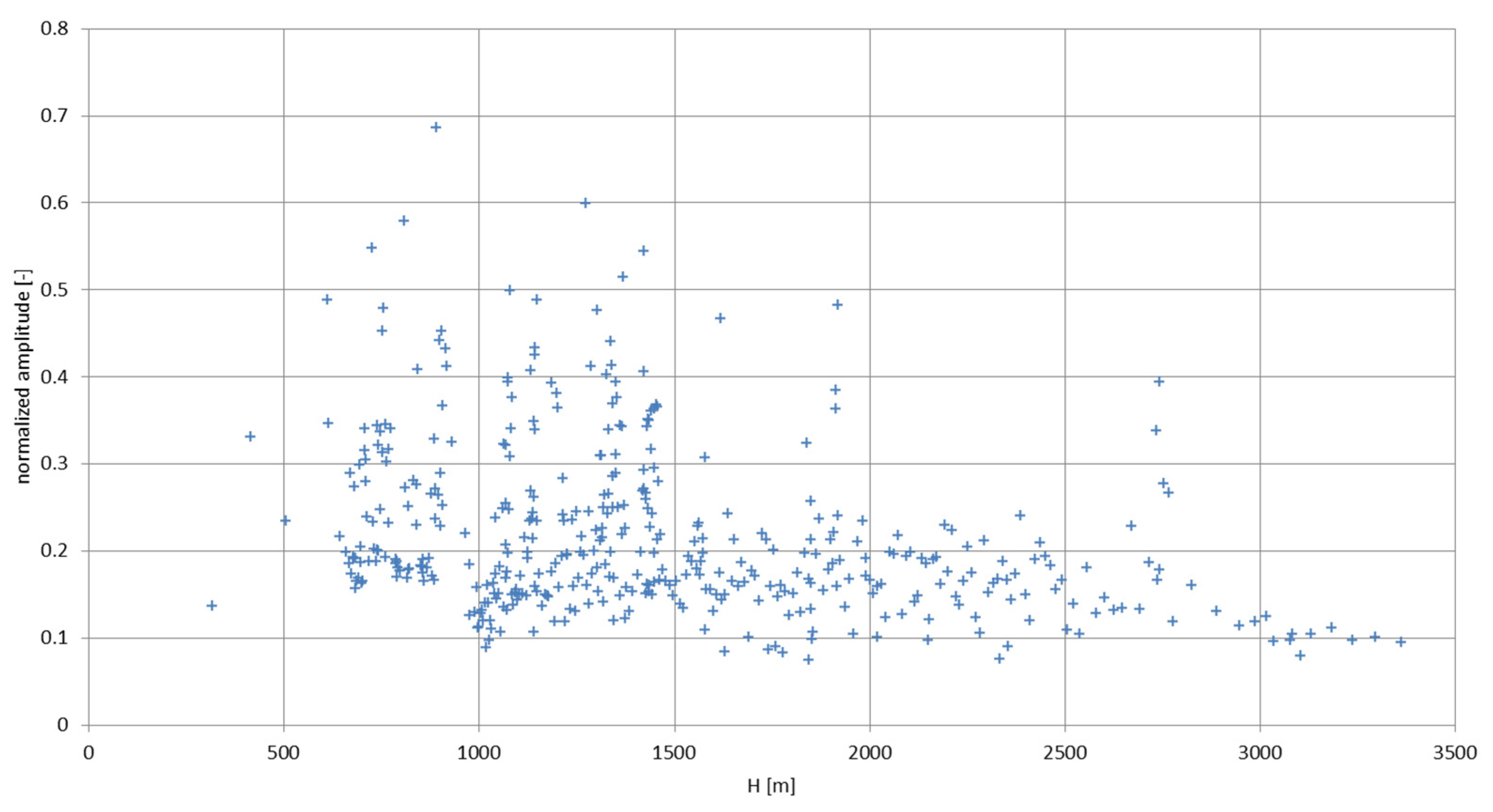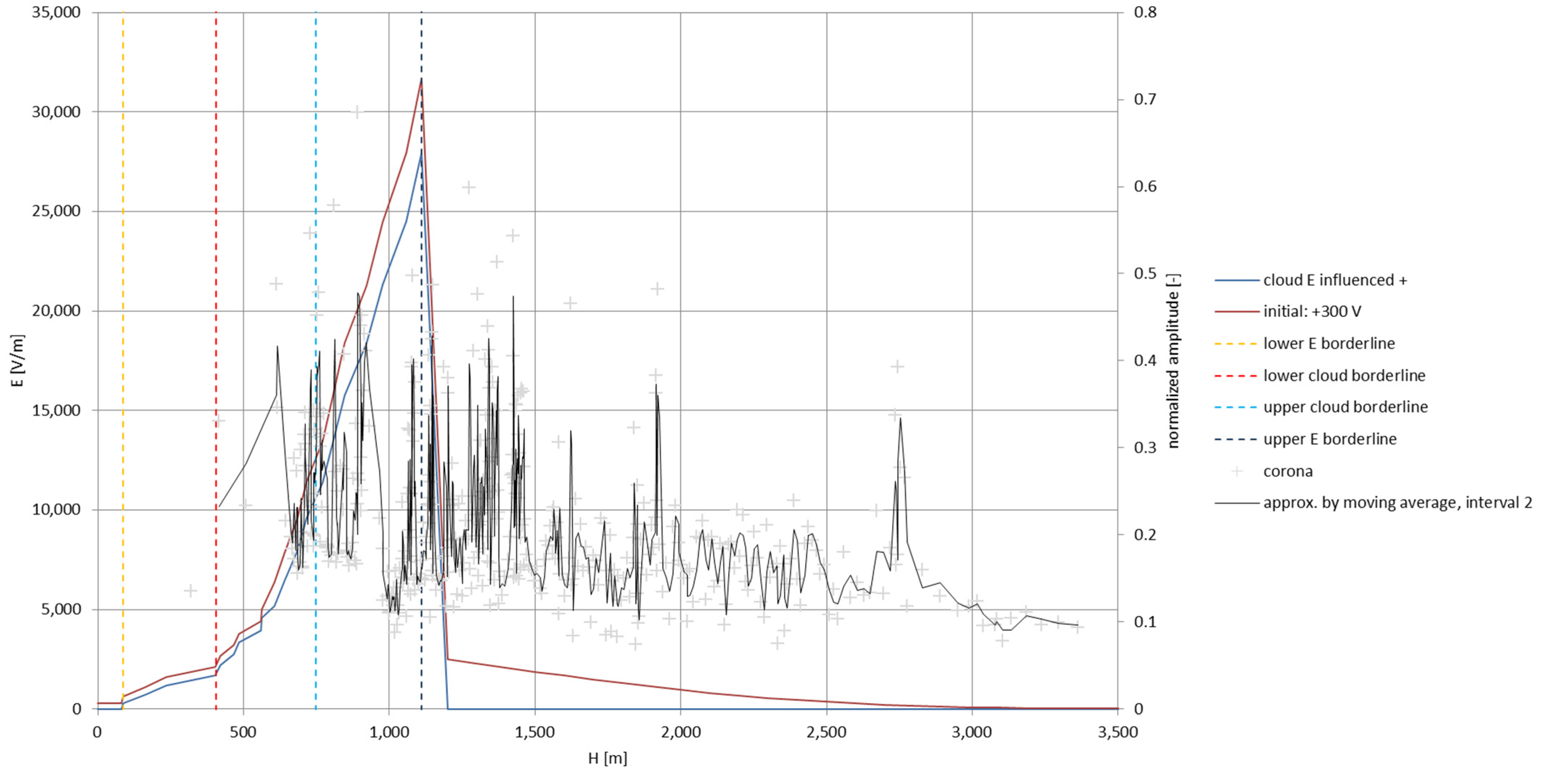The balloon-borne VLF antenna in this analysis—both theoretical and experimental —has the form of a tape-like flat aluminum wire having total length
L of 140 m, width
b of 15 mm, and thickness
d of 0.1 mm, with one side covered with plastic-coated paper (
Figure 4). The electrostatic interactions with the atmosphere are related to the surface of the conducting object, so, in this case, the following formulas (originally derived for small objects [
17]) refer to the area
L·d (m
2), with the assumption that the physical phenomena responsible for the accumulation and loss of electric charge remain the same.
3.1. Static Electric Field Model
During the ascent phase, the balloon mission, with a long vertical antenna, travels through three basic types of regions—cloudless, electric field in proximity to the cloud, and electric field inside the cloud.
The cloudless zone exhibits electric charge exponential loss with the time constant, τloss, dependent on the altitude, as defined by Formula (1).
The zone with electric field in proximity to the cloud—with particle density lower than inside the cloud—exhibits both electric charge accumulation and loss, with the maximum electric charge,
Qmax. (C) formulated as follows [
13]:
where ε
0 ≈ 8.854 F/m is the electrical permittivity of vacuum, and
E (V/m) is the external electric field intensity. This maximum value is reached exponentially in time, with the time constant derived from the experimentally defined charge accumulation rate,
vC (in this analysis, equal to 0.3 × 10
−13 C/m
3/s [
17], and 10
4 times more for the storm cloud conditions):
Therefore, the electric charge accumulation and loss in this region can be defined as follows:
The definition of electric field strength at a given distance r (m) from the wire remains under an assumption that the distance,
r, is defined between the wire and an imaginative second electrode in the cloud or surrounding air (as there are no such electrodes in real experiments [
12]). The electric potential distribution around the analyzed wire can be defined as follows [
23]:
where
c is the half of the wire’s length (here equal to 70 m), and distance r is assumed at 1 m. In real conditions, the distance,
r, is a variable dependent on the actual shape of the cloud and the position of the equipment in relation to the cloud’s electric charge concentrations (if assumed that they could be considered as the ‘2nd electrodes’). The exemplary experimental electric field strength data used in this comparison do not indicate any more information related to the geometry of the measuring equipment/environment (e.g., the distance between the probes), presenting the electric field strength values only. If the aforementioned assumption is maintained and a simulated (or experimental) cloud shape is delivered, a distance, r, could be introduced as a defined non-unitary value; however, this would limit the usefulness of the calculations, as the considered clouds present a lack of repeatability in this geometric scale (except their general types and substructures). Hence, the unitary value of the distance, r, was assumed.
By using this formula, the electric field intensity,
EI (V/m), around the electrified wire in this region can be derived:
The third zone—the inside of the cloud—can be characterized by an increased rate of electric charge accumulation and negligible charge loss; thus, Formula (8) is reformulated into the following [
17]:
resulting in the respective formula for the electric field strength,
EII (V/m):
The external electric field strength, E, can be taken directly from the experimental data shown in
Figure 3; as these functions are altitude-dependent, to form such dependence in Formulas (12) and (13), the time,
t (s), can be substituted with a ratio
H/vZ, where
H (m) is the altitude, and
vZ (m/s) is the ascent rate of the balloon mission (chosen arbitrarily or based on the actual flight data).
Additional elements of the electrification process of the balloon-borne wire are the electric charge acquisition during the takeoff procedure and the creation of potential difference during the freezing of remains of liquid water remaining on the system.
As the wire antenna of the balloon mission is lifted up from the ground from a lying-down, already-deployed position, it remains in a rubbing contact with the partially conductive substrate (the airfield—humid grassy surface). As the antenna rises, a difference of electric potential appears as an effect of the separation of charges between the wire and the ground [
24]; assuming that the dielectric compound of the aluminum antenna (the supportive substrate of the wire) is partially composed of polyethylene, the maximum electric field strength resulting from this mechanism can be approximated as +300 V/m (lower than the mean value for different types of polyethylene due to expected irregularities in the process from the rugged airfield surface) [
25].
In the mid-1940s, the works of Workman and Reynolds, as well as Gunn and Dinger, showed that, during the freezing process of water, an increase of the electric potential can be observed [
26]; this process is able to produce electrical currents as high as 1 microampere and is experienced only during the freezing (does not manifest itself after the freezing stops) [
27]. In the current analysis, the freezing of possible water that remains accumulated on the antenna system may occur in the Ns clouds at the altitude of the 0 °C isotherm, around the altitude of 4.2 km from the data set in
Figure 3. The maximum electric potential difference reached in this manner is +230 V (ice positive) [
26,
27].
The ‘static electric field model’ approach mentioned in the title of this section means that it is assumed here that the balloon mission does not interfere with the electrical structure of the clouds, thus allowing the use of encountered external electric field strength, E, in Formulas (11) and (13) (as presented in
Figure 3). This does not necessarily correspond to the reality, as the balloon mission moves through the atmosphere with velocities low enough for it to be considered as a disturbance in the cloud’s structure, which is theoretically able to modify its composition and the existing electric field (as mentioned in
Section 2.1). Therefore, for comparative purposes, a ‘dynamic electric field model’ is proposed below.
3.2. Dynamic Electric Field Model
The basis for the definition of the possible influence of the slow-moving balloon mission with a long vertical antenna on the electric field in the cloud and its proximities is the assumption that, during the passage of the balloon mission, the cloud remains in a quasi-constant state, which can be described by the equation of cloud equilibrium [
17]:
which describes the current densities (A/m
2) in different electrified regions, with
E (V/m) defined as previously, and
λ (S/m) as the conductivity of the given region.
The three electrified regions—below the cloud, inside the cloud, and above the cloud —physically do not exist as a discontinuous formation; that is, the passage from one zone to another is smooth and continuous. Therefore, if discretized for different adjacent altitudes, H, the equation takes the following form:
If the adjacent step’s index is changed from
H to a common
i,
E′ is introduced as the value of the electric field strength modified by the presence of the antenna wire, and the index
A is introduced as the one describing a parameter related to the antenna wire itself. Thus, Formula (15) can be expanded as follows:
where α (–) is the ratio of the antenna wire volume to the volume surrounding it with the boundary of
r = 1 m (similarly to the assumption in the previous section). The modified electric field strength,
E′, in the next (
i + 1) step can be easily calculated from this formula; this value shall be then used in Formulas (11) and (13). The mode of employment of Formula (16) is recursive; that is, the antenna electric fields calculated from (11) and (13) become
EA in the next calculation step (next altitude value), along with the respective
Ei value from the cloud (
Figure 3).
The values of the conductivities in the clouds can be calculated by using the experimental electric field values and the current densities—for the Ns clouds, under a macroscopic (large area) approach the current density reaches 10
−7 A/m
2; for the Sc clouds, assuming that the maximum conductivity may reach 1/25 of the conductivity of clear air (mean clear air value: 1.5 × 10
−14 S/m [
28]), the current densities in the central part of the Sc clouds reach values between 0.7 × 10
−13 and 2.5 × 10
−13 A/m
2 [
17].
3.3. Theoretical Simulation Results
To simulate the gain and/or loss of electric field strength of a balloon-born vertical wire (dimensions given in
Section 3), the calculations were performed for two cases—‘static’ and ‘dynamic’ (or influenced)—using data points (
H;
E) plotted in
Figure 3. The altitude axes were divided into subsequent calculation stages, or zones, where specific phenomena of electric charge accumulation and loss appear:
Zone I: charge loss in clear air—Formulas (1) and (2), charge accumulation during takeoff, resulting in initial rise of electric potential (expanded to two cases: +300 V and −300 V),
Zone II: charge loss and accumulation in the proximity to the cloud—Formula (11),
Zone III: charge accumulation in the cloud—Formula (13); for the Ns clouds, the additional short local increase of electric potential of +230 V due to freezing of possible water remains at the 0 °C isotherm,
Zone IV: charge accumulation and loss above the cloud (with non-negligible external electric field strength), approximated by Formula (11),
Zone V: charge loss in clear air—Formulas (1) and (2)–(5)—depending on the upper borderline of the electric field occurrence.
The ‘dynamic’ cases were expanded by using Formula (16), as described above. In all cases, the
vZ (ascent velocity) was defined as 3 m/s (consistent with experimental flight readings); the parameters of the antenna wire are used as defined in
Section 3 (
L = 140 m). For comparative purposes, a calculation of results for two lengths of wires—10 and 500 m—was also carried out. The calculated electric field strengths were summed with the external electric field strength in order to correspond to the worst-case scenario, where the total electric field strength may appear high enough to induce discharges.
It can clearly be seen that the maximum values of the electric field strengths for all cases are significantly higher for the ‘dynamic’ cases, where the external electric field in the cloud and in cloud proximities is influenced by a long electrically charged object of different conductivity—the cloud, to maintain its equilibrium according to general Formula (14), for a changing conductivity elevates the electric field strength in the region where the disturbance takes place, as in Formula (16). As the local differences in conductivities reach many degrees of magnitude (air/cloud vs. aluminum), the local electric field strengths are expected to locally increase significantly to compensate for this, according to the assumed aforementioned mechanisms; hence, there are large differences in the E values between the models. For the Sc clouds, the ‘static’ model of electrification presents electric field strengths rarely exceeding 0.5 kV/m, while for the ‘dynamic’ charging model, the values may reach up to 30 kV/m for both Sc and Ns clouds—despite their significant differences in initial electric field strengths, as shown in
Figure 3 (this shows that the main causes for the increase of electric charge and electric field strength are the charging mechanisms, not the external electric field itself). The ‘dynamic’ model shows that, for the increasing values of the electric field strength inside the Ns clouds, with the mechanisms of electrification and charge loss adapted to these conditions, the difference between the antenna E values and the cloud’s E values starts to decrease; this effect may be accelerated by the initial course of the cloud’s
E function. For all cases, the electric field strength drops rapidly after the exit from the zone with external electric field in proximity to the cloud—a result of the increased conductivity of the surrounding air. For the Ns clouds, an increase of the electric field strength can be seen after the exits from the cloud regions (above the upper cloud borderlines)—the effects of changing electric charge accumulation mechanisms. The ‘static’ model clearly shows the electric field strength increase due to freezing of the water residue at the 0 °C isotherm (E value peaks repeating in ‘(a)’ plots shortly above 4000 m of altitude)—this mechanism is perceptible in the ‘dynamic’ model as short increases of the E’s derivatives, which moderately accelerate the electric field strength growth.
Figure 12 presents the comparison for ‘static’ and ‘dynamic’ models for two and three (respectively) wire antenna cases of different lengths for the positively polarized Sc cloud. As expected, the longer wire, in all cases, produces higher electric field strengths (facilitating the occurrence of corona, which is consistent with Reference [
21]); the calculations, however, do not include any possible discharging processes resulting from the shunting effect of a wire of that significant length (comparable to the dimensions of the smaller clouds).
During the parachute-descent phase of the balloon mission—after the balloon explodes at maximum altitude or the payload is deliberately cut off the balloon at target altitude—the antenna, if designed properly, shall also move in a vertical position and enter the cloud with a velocity, v
Z, approximately five times higher than during the ascent (the velocity, v
Z, slowly decreases with altitude, as, with the increasing density of the air, the parachute operates more and more effectively). This type of cloud entry and the electrostatic interactions between the wire antenna and its surroundings were simulated and are shown in
Figure 13,
Figure 14,
Figure 15,
Figure 16,
Figure 17,
Figure 18 and
Figure 19 (antenna dimensions as presented in the beginning of
Section 3; L = 140 m). The initial electric field strength of the antenna is 0, as it is assumed that the antenna lost its electric charge during the stay at higher altitudes with higher air conductivity.
The residual electric field strengths, remaining during the landing, differ between the cloud types and interaction models, but rarely exceed ±500 V/m. The five-times higher vertical velocity decreased the maximum electric field values reached in most cases in both models (while still the ‘dynamic’ model provides values one degree of magnitude higher than the ‘static’ approach)—this mechanism can be extrapolated for even higher, airplane-typical velocities, which would result in even lower differences between the total electric field strength and the external electric field strength—proving that the fast-moving aircraft is less prone to accumulating a large amount of electric charge in comparison with a slowly moving aerostat. For the Ns clouds, the cloud re-entry starts at the altitude, with higher conductivity than in the Sc cloud cases, thus preventing the electric field strength coming from the charging antenna to develop a significant difference between itself and the external electric field.
Table 1 presents the values of residual electric field strengths present at landing for different re-entry cases. For the dynamic cases, at the exits from the storm clouds, the lower air conductivity with different mechanisms of charge accumulation allows a significant residual electric charge to be present that shall discharge during the landing—a similar case to the LZ129 ‘Hindenburg’ disaster, which traveled through storm clouds prior to the landing attempt at Lakehurst [
10].
The maximum values of the electric field strength reached on all the presented plots are significantly lower than the values of the corona breakdown electric field strengths, as mentioned in
Section 2.1—this, however, does not necessarily mean that the corona is not likely to appear on the wire, as the presented electric fields have been calculated at a fixed distance r of 1 m—in the local zones closer to the surface of the wire, the electric field strength may reach the corona breakdown value. This is most likely in the approximate altitude ranges read from the plots (common for given model and flight stage):
100–800 m—Sc, ‘static’ model, ascend and re-entry phases,
900–1300 m—Sc, ‘dynamic’ model, ascend phase,
>200 m—Sc, ‘dynamic’ model, re-entry phase,
4–7 km—Ns, ‘static’ model, ascend and re-entry phases,
8–10 km—Ns, ‘dynamic’ model, ascend phase,
0.1–2 km—Ns, ‘dynamic’ model, re-entry phase.
Both presented electrification models show increased charge gain on the antenna wire, despite the included functions of charge loss and, for the descent phases, increased velocity—this remains consistent with the influence of the electrification processes that drive the evolution and maturing of the clouds on other objects that appear in their proximities or insides [
17]. The electric charge loss, depicted as faster at higher altitudes and slower at lower altitudes, due to changing conductivity of the air, can be related to the reported higher occurrence of lightning strikes appearing at lower altitudes on the aircraft [
9]—as the aircraft is subjected to higher electric charges facilitating the formation of lightning.
The model that is considered most correctly describing the actual antenna wire electrification processes when passing through the clouds and their proximities is the ‘dynamic’ model, as it includes the expected (at given velocities of the balloon mission) influence of the antenna on the cloud’s electrical structure as a sort of an artificial disturbance. The ‘static’ model was built on simpler formulas which rely directly on the electrification processes in the clouds and the atmosphere, yet do not include the functioning of the cloud as a uniform, self-equalizing system—this appears as a crucial assumption for modeling electrostatic interactions which do resemble those appearing in reality in maturing charged clouds.
As both models did not possess an implemented breakdown/lightning-strike condition (this depends on the local structure of the cloud, which varies for every existing cloud), the model that showed the highest possibility of the occurrence of breakdowns is also the dynamic one, as in this model, only the electric field strength derivatives inside the clouds appear sufficiently large to sustain the rapid electrification after a possible discharge—a widely reported property of a highly electrically active cloud [
17], imperceptible in the static model.
The dynamic model results may be compared to the experimental results, which concentrated on the monitoring of corona appearing on the balloon-borne wire antenna of the same dimensions as in the simulations, traveling directly through a warm storm front.
